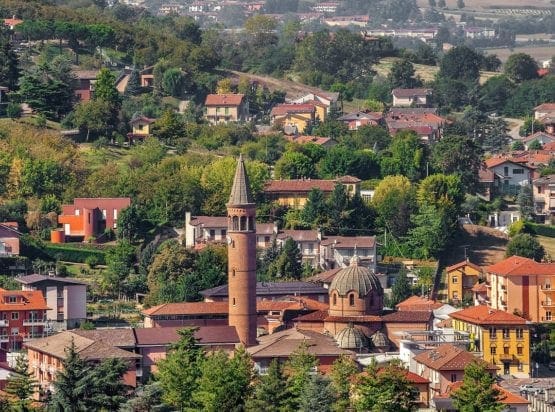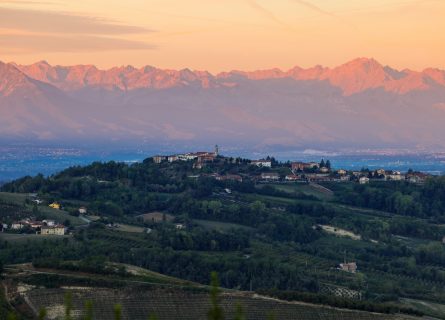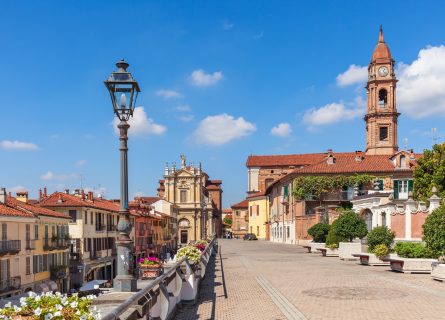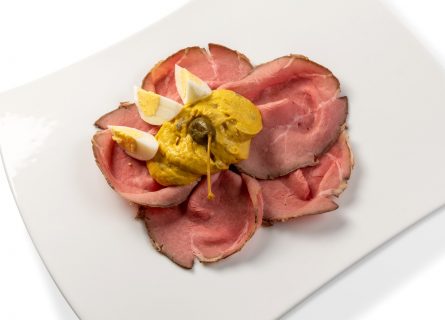Discover Alba, Piedmont's culinary jewel, famed for truffles and wines. Explore rich history and gourmet paradise in Italy's food and wine capital.
Read more
EXPLORE ALL OUR PIEDMONT WINE REGION GUIDE
Last updated: July 9, 2024
Indefatigable in their love for Nebbiolo, wealthy collectors will pay lavish sums for the best red wines of Barolo and Barbaresco in northwest Italy. And who can blame them? After all, Nebbiolo reaches the summit of perfection in the fog-covered Langhe hills, south of the River Tanaro. Much like Grand Cru Burgundy, these are wines of character, complexity, potency, and finesse. And, thanks to the marketing genius of men like Angelo Gaja, people now take them as seriously as Musigny and Chambertin.
However, Italian viticulture has no monopolies – not even in Piedmont! Capricious yet utterly brilliant, Nebbiolo does not have to be grown in Barolo to make structured and aromatically complex wine. The most compelling evidence comes from the vineyards of Roero, situated on the River Tanaro’s left bank in Piedmont.
After years of languishing in obscurity, buyers and sommeliers are paying more attention to these ‘outlying’ regions, not least because of rampant inflation in the US and elsewhere. And Roero is no stranger to the vine; archaeologists have discovered wine amphorae dating back to Etruscan times in the undulating landscapes of northwestern Italy.
Meanwhile, the fragrant, pear-scented Arneis grape, a local specialty of the appellation, only adds to Roero’s appeal. Two great wine styles for the price of one? That sounds like a bargain to us.

Nebbiolo thrives in the Roero hills northwest of Alba – a bucolic paradise overshadowed by the impressive spectacle of the snow-capped Alps. In this timeless scene, vines carpet the light, sandy soils of the River Tanaro’s left bank, carefully managed by growers and their families.
Today, approximately 1180 hectares are under vine, distributed across a reasonably wide area between the town of Bra and the village of Govone, close to the border with the Asti region. The local climate, meanwhile, is renowned for its very dry summers and cold winters. In July and August, temperatures routinely exceed 80°F, and rainfall is extremely scarce.
Soil Composition and Water Management
Indeed, Roero is one of the most arid regions in Piedmont. The prevalence of sand and marlstone ensures that drainage is rarely an issue in the zone due to their high levels of permeability. Yet unlike clay, sandy terrain does not retain water well—drought has increasingly become a real problem over the past few years.
In extreme cases, the vignoble receives less than 400 mm of rain annually, although winter snowfall can help replenish soil moisture levels. But there is also the risk of stormy weather and hailstorms in the vineyards of Roero. All in all, this is both a rewarding and challenging place to make wine.
Nevertheless, the landscape is stunning. Roero is a sea of dome-like hills formed over two million years ago during the Pliocene period of global cooling. Before that event, much of northern Italy was submerged under the Po Valley Gulf, a vast inland sea extending to modern-day Switzerland’s boundaries. This is why sand and calcareous soils are commonplace in the wider region – a product of millions of years of climate change and tectonic activity.
Viticultural Practices for Nebbiolo
As a rule, producers tend to reserve their best climats (vineyard sites) for Nebbiolo, a grape that requires a great deal of sunshine and warmth to achieve full physiological ripeness; unripe Nebbiolo, tart, and astringent, is best used for distillate. Yet, there is no paucity of south-facing slopes in these rolling hills, sheltered from the prevailing winds and occasional hailstorms.
Bathed in the afternoon sunshine and planted on mineral-rich, sandy soils, Nebbiolo yields a very fragrant, elegant style of red that is perhaps lighter than Barolo or Barbaresco. Likewise, the best Arneis of Roero displays poise and elegance, featuring crystalline fruit and lovely fresh acidity. Winemakers normally cultivate it at higher elevations and on north-facing slopes to avoid the intense afternoon heat. The goal is to slowly ripen Piedmont’s ‘little rascal,’ producing a white that balances concentration with freshness.
The winemaking culture in Roero has changed out of all recognition over the past 25 years. In the 20th century, many winemakers favored a warm fermentation in old oak vats, leaving the wine in contact with the skins for up to one month. The result was a powerfully structured red that could take a decade – or more – to reveal its fruit and finesse, with a tannic bite that many found unpalatable in its youth.
Growers like Bruno Giacosa and Conterno in neighboring Barolo remain committed to this approach and have no shortage of buyers prepared to spend considerable sums on these traditional Nebbiolo icons.
However, Roero lacks the cachet of its more established rivals; it cannot afford to produce wines that need ten years in bottle to soften and open up. And so, despite the strong wish to preserve heritage and traditions, the use of modern technology and, whisper it, French oak has become far more accepted and normalized in the appellation.
According to the DOCG rules, all red wines must contain a minimum of 95 percent Nebbiolo – this is different from Barolo and Barbaresco, which do not allow any other varieties in the wine.
Adapting Old Practices
Historically, producers would blend a tiny amount of Arneis to add perfume and freshness. However, this practice is less common today. Furthermore, Roero Rosso will be aged 20 months (six in wood) before it is released. The highest Riserva category, meanwhile, is matured for a further 12 months before the wine can be sold.
Yet, beyond these basic stipulations, the winemaker has a free hand. For example, a little bit of Barbera in the vat is often seen as beneficial to the wine. Moreover, many producers want to preserve fruit aroma and flavor, and the best way of doing that is by vinifying it in stainless steel at low temperatures. Shorter maceration times are also becoming standard policy: moderate tannin extraction prevents astringency and subjugation of the primary fruit. This will likely be followed up with a relatively short period in barrel, giving freshness and fruit priority over oaky flavors.
However, some producers consider woody tannins desirable, maturing their wines in new French oak for perhaps 12 months.
The production of Arneis, meanwhile, conforms to a fairly standardized paradigm. At Paolo Conterno (very much representative of the critical mass), workers hand-harvest berries, sort them, gently press them, and ferment them in stainless steel tanks at controlled temperatures. The vintners then leave the young wine on its fine lees for a few months to add richness and texture before bottling. Occasionally, winemakers mature their top cuvées in oak (rarely 100% new), which can flatter Arneis. Too much, though, will spoil its lovely perfume.

It is easy to be awestruck by the blue-chip wines of Barolo and Barbaresco—Gaja and Giacomo Conterno – the single-vineyard labels of Rinaldi and Sandrone. You will have probably heard these wines described as the greatest of their kind. And “great” is a big word to throw around: it engenders high expectations from enthusiasts and oenophiles. However, as the quality of Nebbiolo from Piedmont’s less famous appellations improves with every vintage, there is a strong argument for broadening your horizons.
Broadening Horizons: The Case for Roero
So our advice is simple: forget the “world’s best” idea. Think locally. Exploring the wines of Roero offers as much pleasure and enjoyment as purchasing cult labels from gold-plated vineyards. With the benefit of significant recent investment, producers in Roero are now making some seriously worthwhile Nebbiolo – awe-inspiring stuff. This became apparent during an extensive tasting conducted in 2021, organized with the support of various consorzios and promotional bodies in Piedmont.
Of course, not every bottle of Roero Rosso – or indeed Bianco – was of exceptional quality; however, the critical mass of wines showcased good fruit and vibrant aromatics, with notes of blackcurrant, violets, forest floor, and truffle on the mid-palate. One year later, a blind tasting (sampling Barolo, Roero, and Monferrato wines) confirmed our initial suspicions. The historic vineyards of these twin appellations do not hold a monopoly on superlative Nebbiolo wines.
Price and Value
There is also the question of price to consider. How many bottles of high-quality Roero could you buy instead of one bottle of Conterno Monfortino Riserva? The answer is at least 25. In other words, the expense accelerates alarmingly as you get more picky. But please understand us: these truly magnificent reds deserve their venerable reputations. Yet, for a delicious and excellent value drop, look no further than the vineyards of Roero. The hype, for once, is entirely justified.
Discover Piedmont and Nebbiolo: A Noble Marriage of Grape and Terroir. Explore the essence of Nebbiolo in the Langhe hills of northern Italy.
Find out moreExplore Arneis: A Fascinating Journey Through Piedmont's Wine Heritage from Ancient Romans to Modern Resurgence
Find out more
Believe it or not, the town of Bra is something of a celebrity in foodie circles. For one thing, it is the birthplace of Carlo Petrini – the founder of the Slow Food Movement, who also established the world’s first University of Gastronomic Sciences in Roero. It hosts a world-renowned cheese festival that takes place every two years.
The local osterie, too, are very impressive, particularly those that serve tagliolini with freshly shaved white truffle, ‘filetto di manzo,’ and the delectable Vitello tonnato (veal in a tuna sauce). Yes, it really is nicer than it sounds!
A Guide to the Gastronomy and Cuisine of Piedmont: Read more

Discover Alba, Piedmont's culinary jewel, famed for truffles and wines. Explore rich history and gourmet paradise in Italy's food and wine capital.
Read more
Torino: A dynamic blend of royal history, industrial innovation, and cultural vibrancy, nestled in Italy's scenic northwestern Alps.
Read moreIf you would like us to customize an exclusive luxury tour, contact us and let us know your travel plans. We offer luxury food and wine tours for private groups of a mininium two guests. In addition, all of our private, chauffeured tours are available year-round upon request.

